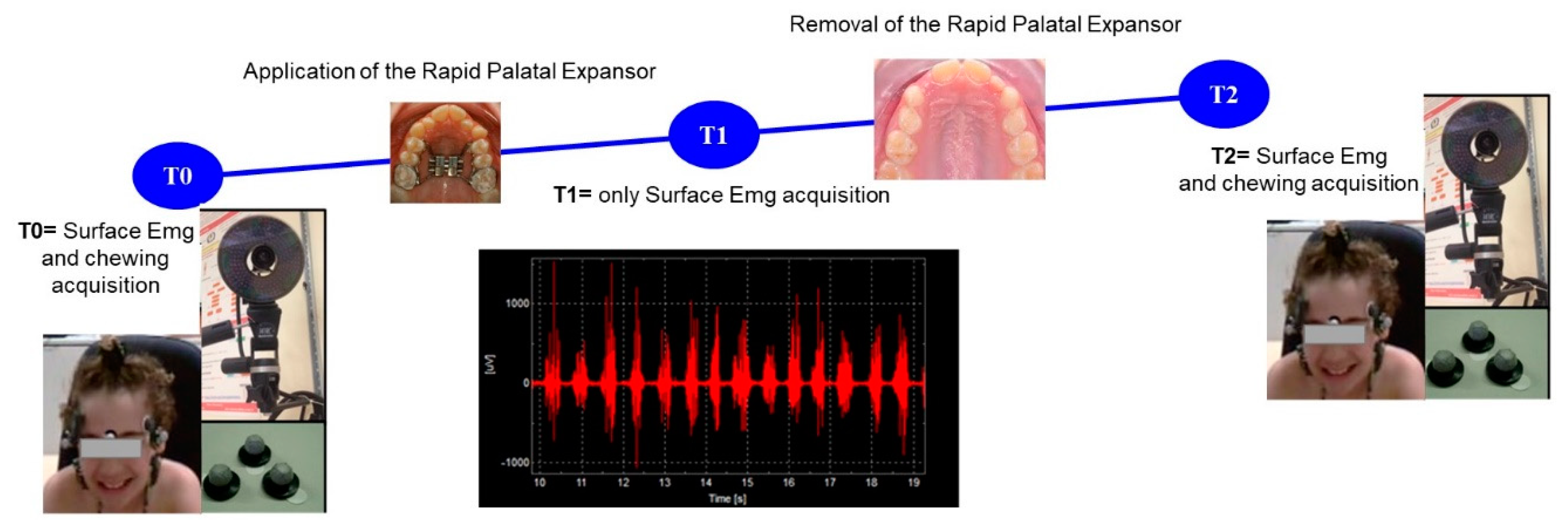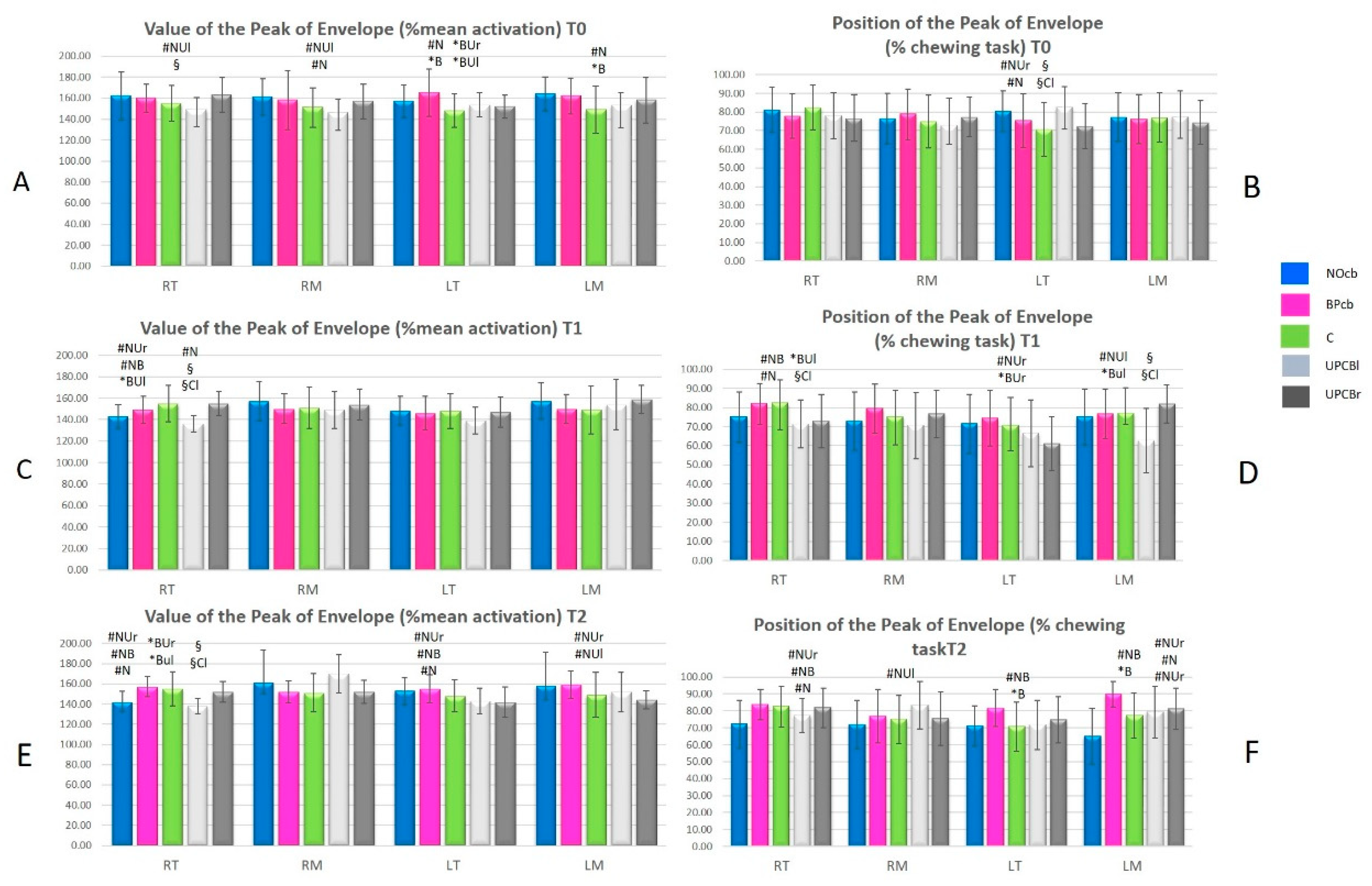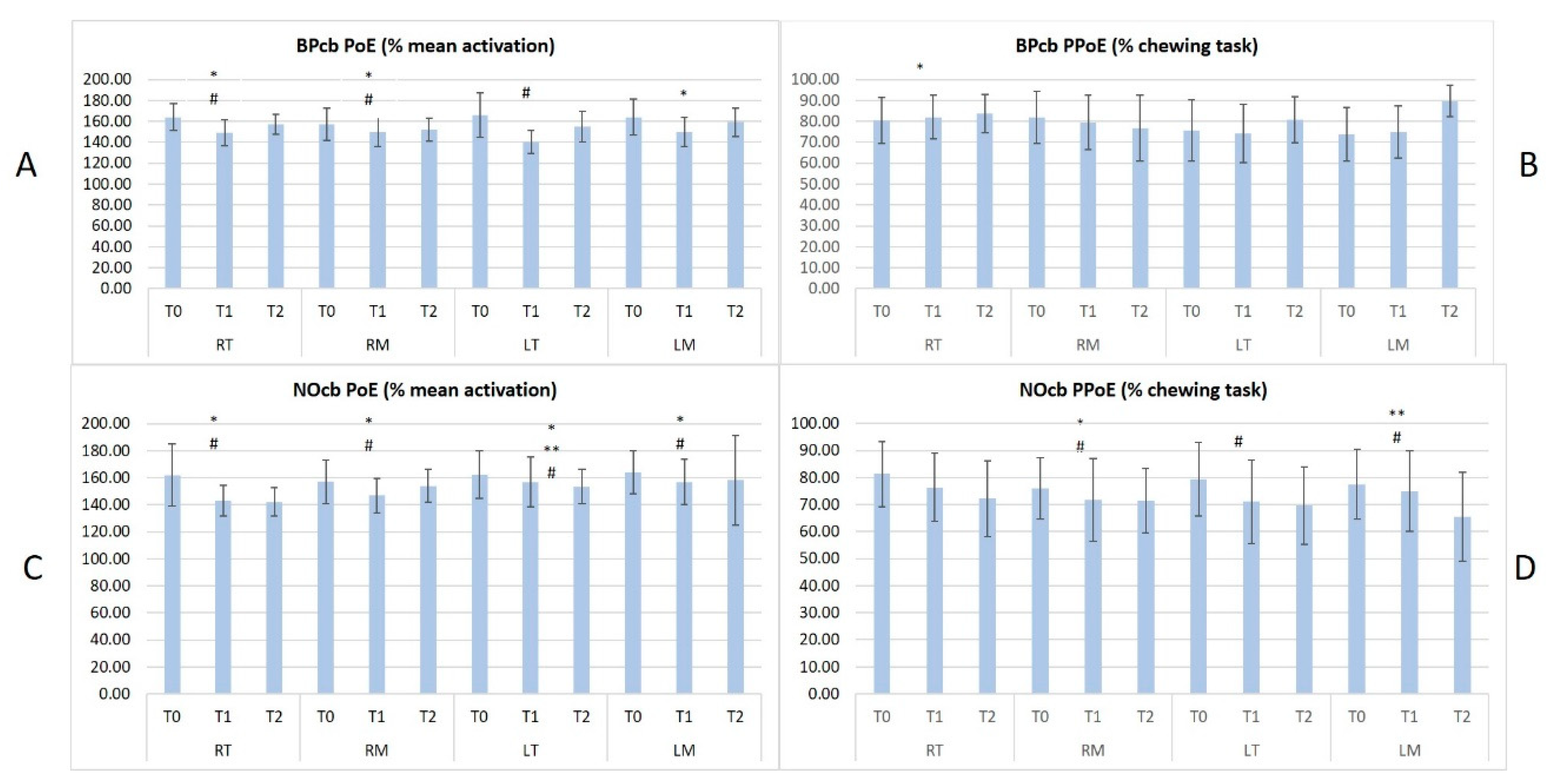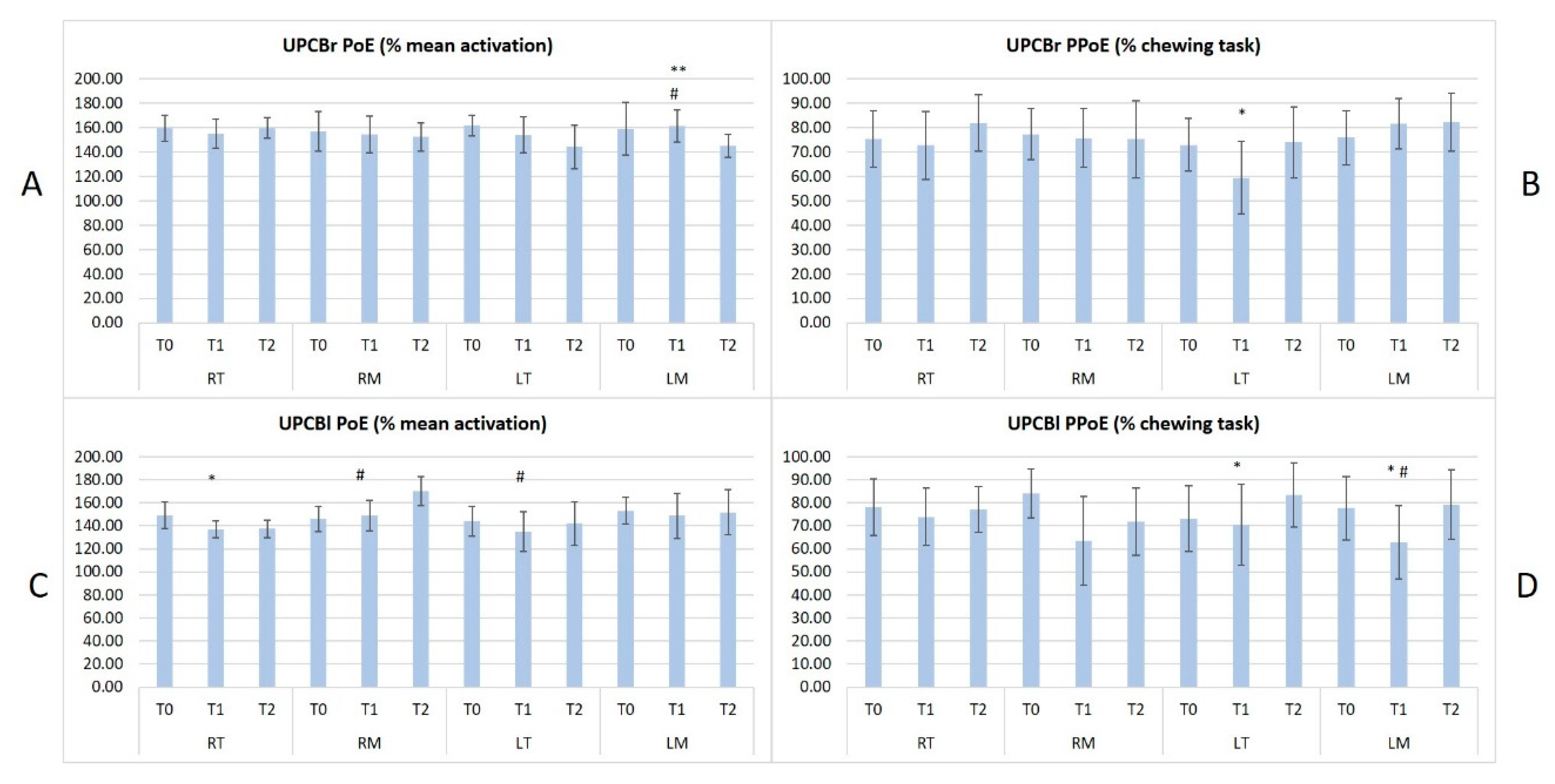Effects of Rapid Palatal Expansion on Chewing Biomechanics in Children with Malocclusion: A Surface Electromyography Study
Abstract
1. Introduction
2. Material and Methods
2.1. Subjects
2.2. Instrumental Protocol
- 6-camera motion capture system 60–120 Hz (BTS Bioengineering, Quincy, MA US)
- An 8-channel Free EMG system 1000 Hz (BTS Bioengineering, Quincy, MA, US)
- Two web cameras (30 Hz, Microsoft Corporation, Redmond, WA, US)
2.3. Acquisition Protocol
- T0. Before the start of the treatment every subject underwent the sEMG analysis
- Start of treatment with RPE according to individual clinical condition
- T1. Stopping of the expansion (between 4 and 6 weeks after treatment start)
- Removal of RPE 6 months after T1.
- T2. Three months after the RPE removal we performed a check-up visit to evaluate changes and the sEMG analysis was repeated to identify any further change in masticatory strategy.
2.4. Data Analysis
2.5. Statistical Analysis
3. Results
4. Discussion
Author Contributions
Funding
Conflicts of Interest
References
- Bugaighis, I. Prevalence of malocclusion in urban libyan preschool children. J. Orthodont. Sci. 2013, 2, 50–54. [Google Scholar] [CrossRef] [PubMed]
- Castroflorio, T.; Farina, D.; Bottin, A.; Piancino, M.G.; Bracco, P.; Merletti, R. Surface EMG of jaw elevator muscles: Effect of electrode location and inter-electrode distance. J Oral. Rehabil. 2005, 32, 411–417. [Google Scholar] [CrossRef] [PubMed]
- De Felício, C.M.; Sidequersky, F.V.; Tartaglia, G.M.; Sforza, C. Electromyographic standardized indices in healthy Brazilian young adults and data reproducibility. J. Oral. Rehabil. 2009, 36, 577–583. [Google Scholar] [CrossRef] [PubMed]
- Dimberg, L.; Lennartsson, B.; Arnrup, K.; Bondemark, L. Prevalence and change of malocclusions from primary to early permanent dentition: A longitudinal study. Angle Orthod 2015, 85, 728–734. [Google Scholar] [CrossRef]
- Walther, D.; Houston, W.; Jones, M.; Oliver, R. Walther and Houston’s Orthodontic Notes, 4th ed.; Butterworth-Heinemann: Oxford, UK, 2000. [Google Scholar] [CrossRef][Green Version]
- Keski-Nisula, K.; Lehto, R.; Lusa, V.; Keski-Nisula, L.; Varrela, J. Occurrence of malocclusion and need of orthodontic treatment in early mixed dentition. Am. J. Orthod. Dentofacial. Orthop. 2003, 124, 631–638. [Google Scholar] [CrossRef]
- Manfredini, D.; Bucci, M.B.; Montagna, F.; Guarda-Nardini, L. Temporomandibular disorders assessment: Medicolegal considerations in the evidence-based era. J. Oral. Rehabil. 2011, 38, 101–119. [Google Scholar] [CrossRef]
- Woźniak, K.; Piątkowska, D.; Szyszka-Sommerfeld, L.; Buczkowska-Radlińska, J. Impact of functional appliances on muscle activity: A surface electromyography study in children. Med. Sci. Monit. 2015, 21, 246–253. [Google Scholar]
- Larsson, E. Prevalence of crossbite among children with prolonged dummy- and finger-sucking habit. Swed. Dent. J. 1983, 7, 115–119. [Google Scholar]
- Ben-Bassat, Y.; Yaffe, A.; Brin, I.; Freeman, J.; Ehrlich, Y. Functional and morphological-occlusal aspects in children treated for unilateral posterior cross-bite. Eur. J. Orthod. 1993, 15, 57–63. [Google Scholar] [CrossRef]
- Piancino, M.G.; Isola, G.; Merlo, A.; Dalessandri, D.; Debernardi, C.; Bracco, P. Chewing pattern and muscular activation in open bite patients. J. Electromyogr. Kinesiol. 2012, 22, 273–279. [Google Scholar] [CrossRef]
- Pinto, A.S.; Buschang, P.H.; Throckmorton, G.S.; Chen, P. Morphological and positional asymmetries of young children with functional unilateral posterior crossbite. Am. J. Orthod. Dentofacial. Orthop. 2001, 120, 513–520. [Google Scholar] [CrossRef] [PubMed]
- Alarcón, J.A.; Martín, C.; Palma, J.C. Effect of unilateral posterior crossbite on the electromyographic activity of human masticatory muscles. Am. J. Orthod. Dentofacial. Orthop. 2000, 118, 328–334. [Google Scholar] [CrossRef] [PubMed]
- Kecik, D.; Kocadereli, I.; Saatci, I. Evaluation of the treatment changes of functional posterior crossbite in the mixed dentition. Am. J. Orthod. Dentofacial. Orthop. 2007, 131, 202–215. [Google Scholar] [CrossRef] [PubMed]
- Nishi, S.E.; Basri, R.; Alam, M.K. Uses of electromyography in dentistry: An overview with meta-analysis. Eur. J. Dent. 2016, 10, 419–425. [Google Scholar] [CrossRef]
- Sforza, C.; Tartaglia, G.M.; Lovecchio, N.; Ugolini, A.; Monteverdi, R.; Giannì, A.B.; Ferrario, V.F. Mandibular movements at maximum mouth opening and EMG activity of masticatory and neck muscles in patients rehabilitated after a mandibular condyle fracture. J. Craniomaxillofac. Surg. 2009, 37, 327–333. [Google Scholar] [CrossRef]
- de Lucas, B.L.; de Barbosa, T.S.; Pereira, L.J.; Gavião, M.B.; Castelo, P.M. Electromyographic evaluation of masticatory muscles at rest and maximal intercuspal positions of the mandible in children with sleep bruxism. Eur. Arch. Paediatr. Dent. 2014, 15, 269–274. [Google Scholar] [CrossRef]
- Mapelli, A.; Galante, D.; Lovecchio, N.; Sforza, C.; Ferrario, V.F. Translation and rotation movements of the mandible during mouth opening and closing. Clin. Anat. 2009, 22, 311–318. [Google Scholar] [CrossRef]
- Ferrario, V.F.; Sforza, C.; Zanotti, G.; Tartaglia, G.M. Maximal bite forces in healthy young adults as predicted by surface electromyography. J. Dent. 2004, 32, 451–457. [Google Scholar] [CrossRef]
- Ahlgren, J. Pattern of chewing and malocclusion of teeth A clinical study. Acta. Odontol. Scand. 1967, 25, 3–13. [Google Scholar] [CrossRef]
- Piancino, M.G.; Farina, D.; Talpone, F.; Merlo, A.; Bracco, P. Muscular activation during reverse and non-reverse chewing cycles in unilateral posterior crossbite. Eur. J. Oral. Sci. 2009, 117, 122–128. [Google Scholar] [CrossRef]
- Tecco, S.; Crincoli, V.; Di Bisceglie, B.; Caputi, S.; Festa, F. Relation between facial morphology on lateral skull radiographs and sEMG activity of head, neck, and trunk muscles in Caucasian adult females. J Electromyogr. Kinesiol. 2011. [CrossRef] [PubMed]
- Ferrario, V.F.; Sforza, C.; Lovecchio, N.; Mian, F. Quantification of translational and gliding components in human temporomandibular joint during mouth opening. Arch. Oral. Biol. 2005, 50, 507–515. [Google Scholar] [CrossRef] [PubMed]
- Hugger, S.; Schindler, H.J.; Kordass, B.; Hugger, A. Clinical relevance of surface EMG of the masticatory muscles (Part 1). Int. J. Comput. Dent. 2012, 15, 297–314. [Google Scholar] [PubMed]
- Hugger, S.; Schindler, H.J.; Kordass, B.; Hugger, A. Clinical relevance of surface EMG of the masticatory muscles. (Part 2). Int. J. Comput. Dent. 2013, 16, 37–58. [Google Scholar]
- Piancino, M.G.; Falla, D.; Merlo, A.; Vallelonga, T.; de Biase, C.; Dalessandri, D.; Debernardi, C. Effects of therapy on masseter activity and chewing kinematics in patients with unilateral posterior crossbite. Arch. Oral. Biol. 2016, 67, 61–67. [Google Scholar] [CrossRef] [PubMed]
- Lewin, A.; Ramadori, G. Electrognathographics: Atlas of diagnostic procedures and interpretation. Aus. Ortho.J. 1986, 9, 587–3908. [Google Scholar]
- Santana-Mora, U.; López-Ratón, M.; Mora, M.J.; Cadarso-Suárez, C.; López-Cedrún, J.; Santana-Penín, U. Surface raw electromyography has a moderate discriminatory capacity for differentiating between healthy individuals and those with TMD: A diagnostic study. J. Electromyogr. Kinesiol. 2014, 24, 332–340. [Google Scholar] [CrossRef]
- Sawacha, Z.; Spolaor, F.; Guarneri, G.; Contessa, P.; Carraro, E.; Venturin, A.; Avogaro, A.; Cobelli, C. Abnormal muscle activation during gait in diabetes patients with and without neuropathy. Gait Posture 2012, 35, 101–105. [Google Scholar] [CrossRef]
- Sforza, C.; Rosati, R.; De Menezes, M.; Musto, F.; Toma, M. EMG analysis of trapezius and masticatory muscles: Experimental protocol and data reproducibility. J Oral. Rehabil. 2011, 38, 648–654. [Google Scholar] [CrossRef]
- Woźniak, K.; Szyszka-Sommerfel, L.; Lichota, D. The electrical activity of the temporal and masseter muscles in patients with TMD and unilateral posterior crossbite. Biomed. Res. Int. 2015, 259372. [Google Scholar] [CrossRef]
- Scrivani, S.J.; Keith, D.A.; Kaban, L.B. Temporomandibular disorders. N. Engl. J. Med. 2008, 18, 2693–2705. [Google Scholar] [CrossRef] [PubMed]
- Sforza, C.; Montagna, S.; Rosati, R.; De Menezes, M. Immediate effect of an elastomeric oral appliance on the neuromuscular coordination of masticatory muscles: A pilot study in healthy subjects. J. Oral. Rehabil. 2010, 37, 840–847. [Google Scholar] [CrossRef] [PubMed]
- Dong, Y.; Wang, X.M.; Wang, M.Q.; Widmalm, S.E. Asymmetric muscle function in patients with developmental mandibular asymmetry. J. Oral. Rehabil. 2008, 35, 27–36. [Google Scholar] [CrossRef] [PubMed]
- Arat, F.E.; Arat, Z.M.; Acar, M.; Beyazova, M.; Tompson, B. Muscular and condylar response to rapid maxillary expansion. Part 1: Electromyographic study of anterior temporal and superficial masseter muscles. Am. J. Orthod. Dentofac. Orthop. 2008, 133, 815–822. [Google Scholar] [CrossRef] [PubMed]
- De Rossi, M.; De Rossi, A.; Hallak, J.E.; Vitti, M.; Regalo, S.C. Electromyographic evaluation in children having rapid maxillary expan-sion. Am. J. Orthod. Dentofac. Orthop. 2009, 136, 355–360. [Google Scholar] [CrossRef] [PubMed]
- Saccucci, M.; Tecco, S.; Ierardo, G.; Luzzi, V.; Festa, F.; Polimeni, A. Effects of interceptive orthodontics on orbicular muscle activity: A surface electromyographic study in children. J. Electromyogr. Kinesiol. 2011, 21, 665–671. [Google Scholar] [CrossRef]
- Michelotti, A.; Rongo, R.; Valentino, R.; D’Antò, V.; Bucci, R.; Danz, G.; Cioffi, I. Evaluation of masticatory muscle activity in patients with unilateral posterior crossbite before and after rapid maxillary expansion. Eur. J. Orthod. 2018, 41, 46–53. [Google Scholar] [CrossRef]
- Martín, C.; Palma, J.C.; Alamán, J.M.; Lopez-Quiñones, J.M.; Alarcón, J.A. Longitudinal evaluation of sEMG of masticatory muscles and kinematics of mandible changes in children treated for unilateral cross-bite. J. Electromyogr. Kinesiol. 2012, 22, 620–628. [Google Scholar] [CrossRef]
- Forrester, S.E.; Presswood, R.G.; Toy, A.C.; Pain, M.T. Occlusal measurement method can affect SEMG activity during occlusion. J. Oral. Rehabil. 2011, 38, 655–660. [Google Scholar] [CrossRef]
- Manfredini, D.; Cocilovo, F.; Stellini, E.; Favero, L.; Guarda-Nardini, L. Surface electromyography findings in unilateral myofascial pain patients: Comparison of painful vs. non painful sides. Pain. Med. 2013, 14, 1848–1853. [Google Scholar] [CrossRef]
- Haas, A.J. Rapid expansion of the maxillary dental arch and nasal cavity by opening the mid palatal suture. Angle Orthodontist. 1961, 31, 72–90. [Google Scholar]
- Mason, M.; Spolaor, F.; Guiotto, A.; De Stefani, A.; Gracco, A.; Sawacha, Z. Gait and posture analysis in patients with maxillary transverse discrepancy, before and after RPE. Int. Orthod. 2018, 16, 158–173. [Google Scholar] [CrossRef] [PubMed]
- Troelstrup, B.; Moller, E. Electromyography of the temporalis and masseter muscles in children with unilateral cross-bite. Scand. J. Dent. Res. 1970, 78, 425–430. [Google Scholar] [CrossRef]
- Andrade, A.S.; Gavião, M.B.; Gameir, G.H.; De Rossi, M. Characteristics of masticatory muscles in children with unilateral poste-rior crossbite. Braz. Oral Res. 2010, 24, 204–210. [Google Scholar] [CrossRef] [PubMed]
- Maffei, C.; Garcia, P.; de Biase, N.G.; de Souza Camargo, E.; Vianna-Lara, M.S.; Grégio, A.M.; Azevedo-Alanis, L.R. Orthodontic intervention combined with myofunctional therapy increases electromyographic activity of masticatory muscles in patients with skeletal unilateral posterior crossbite. Acta Odontol. Scand. 2014, 72, 298–303. [Google Scholar] [CrossRef] [PubMed]
- Aldana, K.; Miralles, R.; Fuentes, A.; Valenzuela, S.; Fresno, M.J.; Santander, H.; Gutiérrez, M.F. Anterior temporalis and suprahyoid EMG activity during jaw clenching and tooth grinding. Cranio 2011, 29, 261–269. [Google Scholar] [CrossRef]
- Satygo, E.A.; Silin, A.V.; Ramirez-Yañez, G.O. Electromyographic muscular activity improvement in Class II patients treated with the pre-orthodontic trainer. J. Clin. Pediatr. Dent. 2014, 38, 380–384. [Google Scholar] [CrossRef]
- Al-Saleh, M.A.; Armijo-Olivo, S.; Flores-Mir, C.; Thie, N.M. Electromyography in diagnosing temporomandibular disorders. J. Am. Dent. Assoc. 2012, 143, 351–362. [Google Scholar] [CrossRef]
- Ferrario, V.F.; Tartaglia, G.M.; Luraghi, F.E.; Sforza, C. The use of surface electromyography as a tool in differentiating temporomandibular disorders from neck disorders. Man. Ther. 2007, 12, 372–379. [Google Scholar] [CrossRef]
- Egermark, I.; Magnusson, T.; Carlsson, G.E. A 20-year follow-up of signs and symptoms of temporomandibular disorders and malocclusions in subjects with and without orthodontic treatment in childhood. Angle. Orthod. 2003, 73, 109–115. [Google Scholar]
- Klasser, G.D.; Okeson, J. The clinical usefulness of surface electromyography in the diagnosis and treatment of temporomandibular disorders. J. Am. Dent. Assoc. 2006, 137, 763–771. [Google Scholar] [CrossRef] [PubMed]




| BPCB | NoCB | UPCBr | UPCBl | C | ||||||
|---|---|---|---|---|---|---|---|---|---|---|
| Mean | St.Dev | Mean | St.Dev | Mean | St.Dev | Mean | St.Dev | Mean | St.Dev | |
| N° | 10 | 18 | 9 | 6 | 10 | |||||
| Age | 9.40 | 1.51 | 10.61 | 1.72 | 9.67 | 2.55 | 8.25 | 2.60 | 9.80 | 2.20 |
| Height (m) | 1.30 | 0.10 | 1.32 | 0.34 | 1.27 | 0.51 | 1.07 | 0.49 | 1.36 | 0.09 |
| Weight (kg) | 31.17 | 7.60 | 33.44 | 6.71 | 38.89 | 18.89 | 32.31 | 10.24 | 34.00 | 5.14 |
| BMI (kg/m2) | 18.97 | 2.98 | 17.36 | 2.33 | 17.45 | 4.52 | 16.00 | 5.79 | 18.44 | 1.38 |
| Comparison | Symbols in Figure 3 |
|---|---|
| NOcb vs. BPcb | #NB |
| Nocb vs. C | #N |
| Nocb vs. UPCBr | #Nur |
| Nocb vs. UPCBl | #Nul |
| BPCB vs. C | *B |
| BPCB vs. UPCBr | *Bur |
| BPCB vs. UPCBl | *Bul |
| UPCBr vs. UPCBl | § |
| UPCBr vs. C | §Cr |
| UPCBl vs. C | §Cl |
© 2020 by the authors. Licensee MDPI, Basel, Switzerland. This article is an open access article distributed under the terms and conditions of the Creative Commons Attribution (CC BY) license (http://creativecommons.org/licenses/by/4.0/).
Share and Cite
Spolaor, F.; Mason, M.; De Stefani, A.; Bruno, G.; Surace, O.; Guiotto, A.; Gracco, A.; Sawacha, Z. Effects of Rapid Palatal Expansion on Chewing Biomechanics in Children with Malocclusion: A Surface Electromyography Study. Sensors 2020, 20, 2086. https://doi.org/10.3390/s20072086
Spolaor F, Mason M, De Stefani A, Bruno G, Surace O, Guiotto A, Gracco A, Sawacha Z. Effects of Rapid Palatal Expansion on Chewing Biomechanics in Children with Malocclusion: A Surface Electromyography Study. Sensors. 2020; 20(7):2086. https://doi.org/10.3390/s20072086
Chicago/Turabian StyleSpolaor, Fabiola, Martina Mason, Alberto De Stefani, Giovanni Bruno, Ottavia Surace, Annamaria Guiotto, Antonio Gracco, and Zimi Sawacha. 2020. "Effects of Rapid Palatal Expansion on Chewing Biomechanics in Children with Malocclusion: A Surface Electromyography Study" Sensors 20, no. 7: 2086. https://doi.org/10.3390/s20072086
APA StyleSpolaor, F., Mason, M., De Stefani, A., Bruno, G., Surace, O., Guiotto, A., Gracco, A., & Sawacha, Z. (2020). Effects of Rapid Palatal Expansion on Chewing Biomechanics in Children with Malocclusion: A Surface Electromyography Study. Sensors, 20(7), 2086. https://doi.org/10.3390/s20072086











